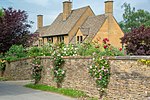Laverton Halt railway station
Disused railway stations in GloucestershireFormer Great Western Railway stationsPages with no open date in Infobox stationRailway stations in Great Britain closed in 1960Railway stations in Great Britain opened in 1905 ... and 1 more
Use British English from December 2016
Laverton Halt railway station was a halt on the Honeybourne Line from Honeybourne to Cheltenham which served the hamlet of Laverton in Gloucestershire between 1905 and 1960. The line through the site of the now-demolished station, lifted after the route's full closure in 1976, has been relaid by the Gloucestershire Warwickshire Steam Railway, with the first service to the site running on 30 March 2011. Whilst the station has not been rebuilt, a run-round was constructed at the site, which has now been removed (May 2016) ready for the extension to Broadway station.
Excerpt from the Wikipedia article Laverton Halt railway station (License: CC BY-SA 3.0, Authors).Laverton Halt railway station
Meadow Lane,
Geographical coordinates (GPS) Address Nearby Places Show on map
Geographical coordinates (GPS)
| Latitude | Longitude |
|---|---|
| N 52.02039 ° | E -1.90467 ° |
Address
Laverton
Meadow Lane
WR12 7NA , Buckland
England, United Kingdom
Open on Google Maps










